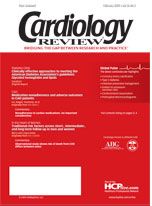Publication
Article
Cardiology Review® Online
Linking left atrial function and postoperative atrial fibrillation
The incidence of atrial fibrillation (AF) following coronary artery bypass graft (CABG) surgery averages between 28% and 40% and is associated with an increased incidence of stroke in elderly patients and a prolonged hospital stay.1 Several mechanisms have been proposed to explain the increased incidence of AF following CABG surgery. Kalman and colleagues found higher postoperative norepinephrine levels in patients with AF following CABG surgery, suggesting that increased sympathetic activation may be an important mechanism.2 Attempting to blunt the sympathetic response with beta blocking agents has been shown to decrease AF in some series, but the incidence is still greater than 20%. There is some evidence to suggest that atrial ischemia during cardioplegic arrest may be an important factor because of less effective cooling of atrial tissue.3,4 However, the incidence of AF does not appear to be lower in patients treated with warm blood cardioplegia techniques or off-pump CABG surgery, in which no cardioplegia is given. Decreased glycogen levels have been found in the atria of patients undergoing mitral valve replacement, suggesting that substrate deficiency may be an important mechanism.5 Indeed, in our own studies with glucose-insulin-potassium (GIK) solutions, my colleagues and I found that the use of GIK significantly decreased the incidence of AF in both diabetic and nondiabetic CABG surgery patients.6,7
In their study of left atrial function using intraoperative transthoracic echocardiography in 300 elective CABG patients, Leung and Bellows (page 36) propose another mechanism for the development of AF in the CABG patient. They found that patients who developed postoperative AF had larger left atrial and appendage areas, lower left atrial ejection fractions before bypass, and decreased atrial systolic function and abnormal left ventricular relaxation after bypass. Patient age was also a significant factor for the development of postoperative AF. They conclude that the structural and functional changes seen in elderly patients with chronic AF are also found in CABG patients with postoperative AF and that the presence of these changes may serve as a guide as to which CABG patients should receive prophylactic therapy to prevent AF.
I agree with the authors’ conclusions that changes in left atrial structure and dimensions can be a contributing factor in the development of postoperative AF. Although my colleagues and I found GIK may have decreased AF due to enhanced substrate utilization, another explanation is its ability to prevent diastolic dysfunction, thus reducing atrial dilation resulting from impaired postoperative ventricular compliance.8 In addition to GIK, earlier use of diuretics, beta blockers, and angiotensin-converting enzyme (ACE) inhibitors may also help to improve ventricular compliance, thereby decreasing atrial distention and ultimately AF.
While these interventions may re-
duce the incidence of AF from 35% to between 16% and 20%, a significant percentage of CABG patients may
still develop postoperative AF. Should patients with abnormal left atrial function assessed by intraoperative trans-thoracic echocardiography be given prophylactic therapy with antiarrhythmics, such as amiodarone (Cordarone or Pacerone)? Daoud and colleagues treated elective CABG and valve surgery patients with amiodarone for 1 week before surgery and reduced the incidence of AF from 53% to 25%.9 However, the 25% incidence was not different from the 28% incidence reported by Leung and Bellows in the absence of prophylactic therapy. Furthermore, earlier studies in which CABG patients received preoperative amiodarone therapy reported a higher incidence of postoperative pulmonary edema, pacing, and the need for in-
tra-aortic balloon and inotropic support.10 Moreover, there is no evidence that the incidence of postoperative AF can be decreased in those patients with abnormal intraoperative left atrial function. A prospective, randomized study will need to be undertaken to determine whether early postoperative prophylactic use of amiodarone will decrease the incidence of AF in these patients.
Until these data are available, treatment of patients with abnormal intraoperative left atrial function under-going CABG surgery should include early initiation of beta blockers and ACE inhibitors as well as more aggressive diuresis in an attempt to decrease left atrial distention and improve ventricular compliance.
